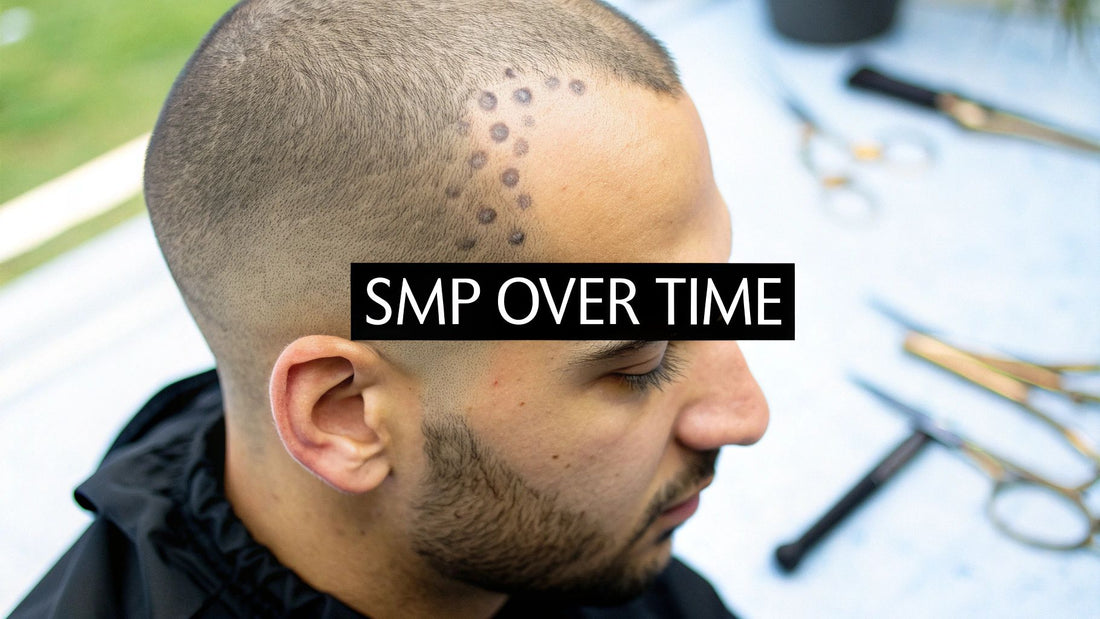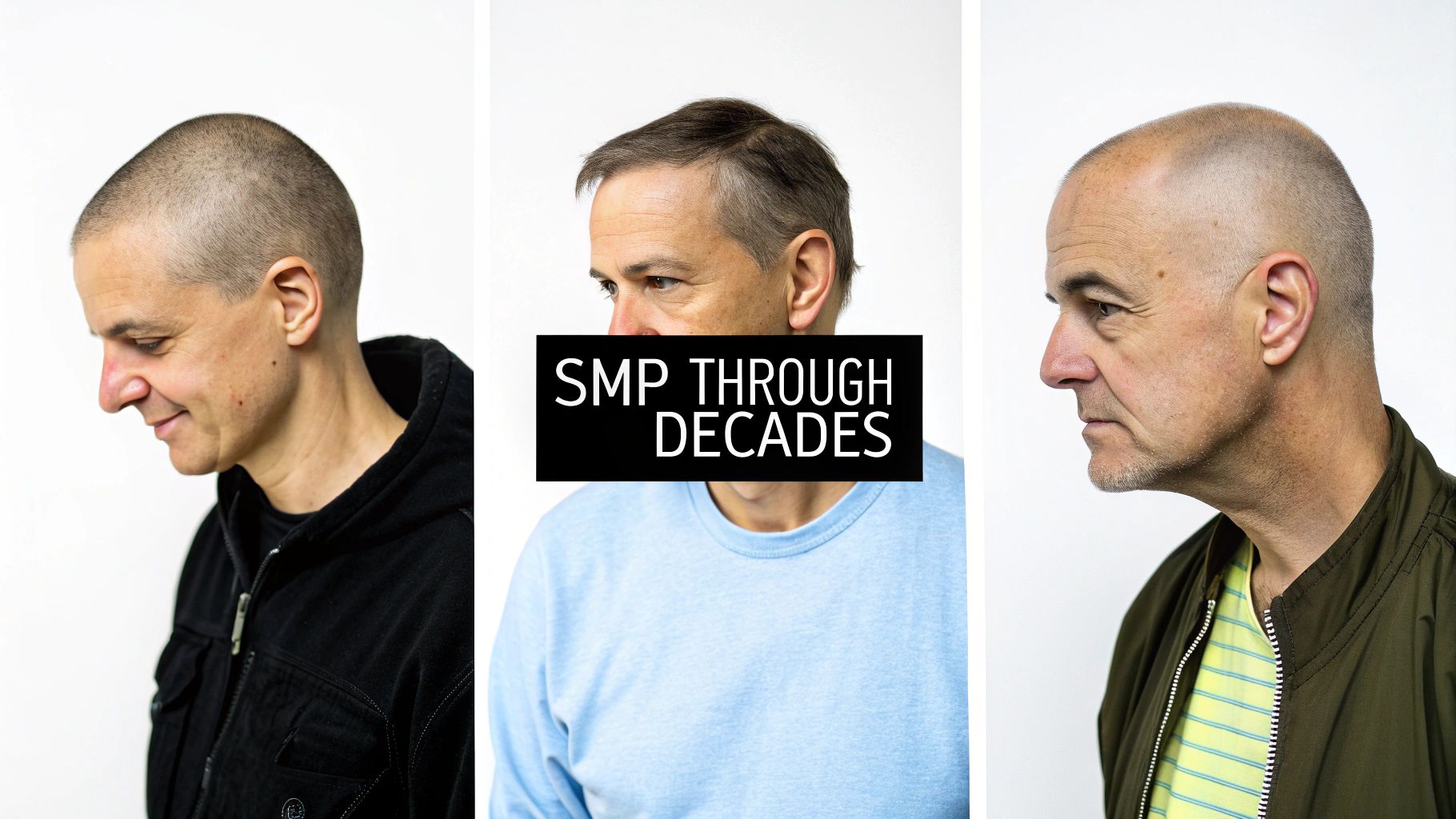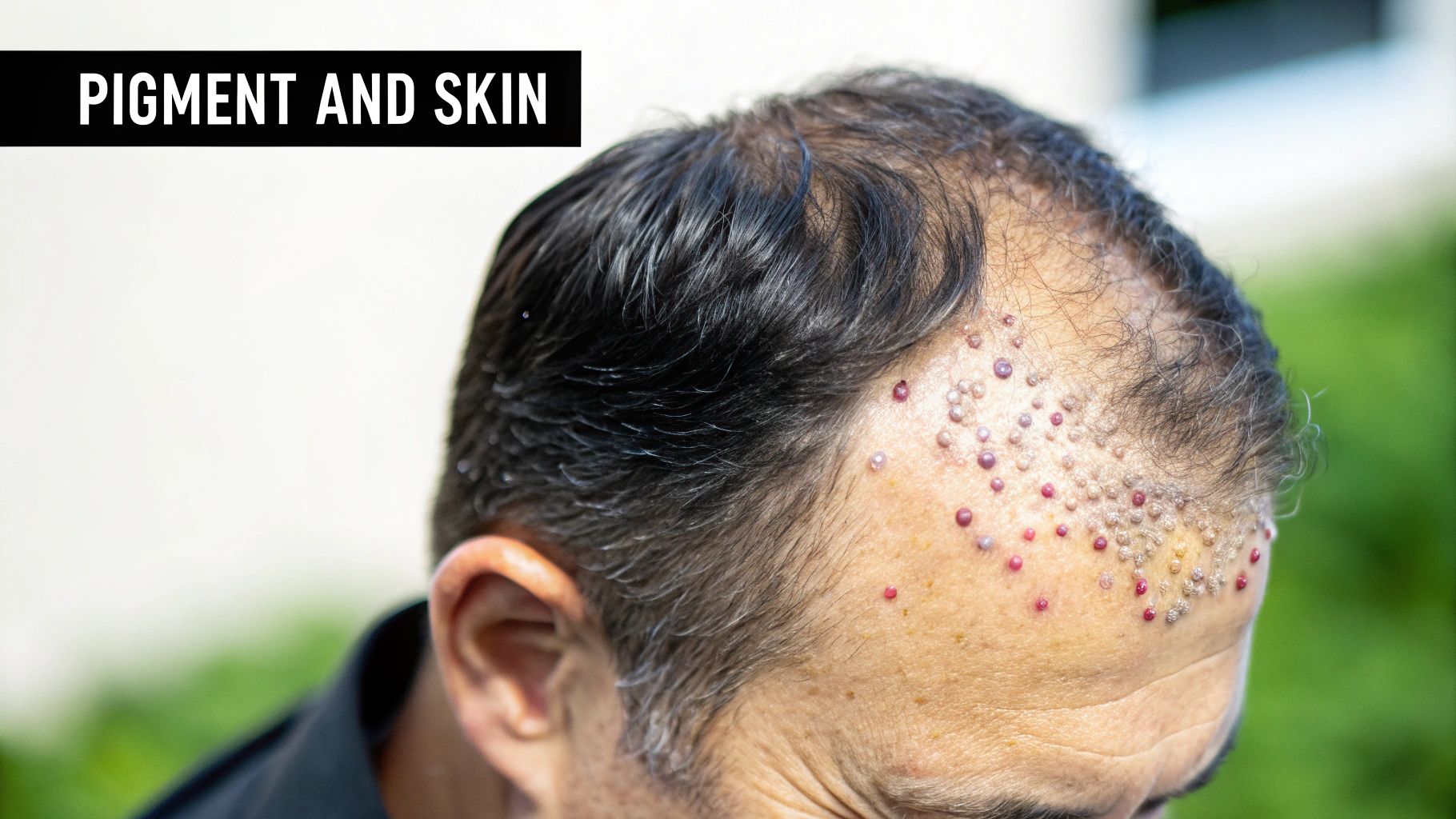
what happens to scalp micropigmentation when you get older?
Share
One of the biggest questions I hear from clients is, "What will this look like in 10, 20, or even 30 years?" It's a great question. You need a solution that not only looks sharp today but also ages with you, blending naturally as your hair grays and your skin changes.
The beauty of SMP is that it’s designed to do just that. It's not a set-and-forget tattoo that might look strange down the line. Instead, it’s a long-term solution that evolves with you, and that’s a feature, not a flaw. This gradual softening is what keeps the treatment looking realistic for decades.
Your SMP Journey Through the Years
Think of SMP as a manageable commitment rather than a permanent, irreversible decision. Its semi-permanent nature is its biggest advantage. The pigments we use are specifically designed to lighten over many years, which prevents that harsh, blueish or greenish tint you sometimes see with old body art tattoos.
This controlled fading process gives you incredible flexibility to adapt the treatment over time. It all starts with a crisp, fresh look and slowly softens until it’s time for a quick refresh.
This infographic gives you a great snapshot of how SMP typically ages.

As you can see, the treatment never just vanishes. It simply loses a bit of its initial definition, which is easily brought back to life with a touch-up session.
A Quick Look at the SMP Aging Timeline
This table outlines the typical evolution of SMP, helping you understand what to expect at each stage of your journey.
| Timeframe | Pigment Appearance | Typical Maintenance |
|---|---|---|
| Years 1-4 | Crisp, defined, and holds its colour well. | Minimal. Focus on sun protection and proper skincare. |
| Years 5-8 | Noticeable softening and lightening of the pigment. | Most clients opt for their first touch-up session around this time to restore density. |
| Years 8+ | The pigment will have faded significantly but is still present. | Regular touch-ups every 3-6 years are recommended to maintain a seamless look. |
This timeline is just a guide, of course. Your lifestyle, skin type, and sun exposure will all play a part in how your SMP ages.
Understanding the "Why" Behind the Fade
So, why does it fade? The whole process involves placing specialised pigments into the upper layer of your scalp's skin, the dermis. Unlike traditional tattoo ink, these impressions are much smaller, shallower, and made with a carbon-based pigment that your body's immune system can slowly break down over time.
To get a deeper insight, it’s worth understanding what scalp micropigmentation is from start to finish. This gives you a complete picture of the journey and the simple maintenance required to keep your look flawless for the long haul.
A great SMP treatment should be completely undetectable. Its ability to fade over time is what allows for crucial adjustments that match your age, whether that means softening the hairline, lightening the shade to blend with grey hair, or just restoring that perfect, dense appearance.
Why SMP Fades and How Your Skin Changes It

To really get what happens to your SMP as you get older, you have to understand how the pigment and your skin work together. It’s best not to think of it like a traditional tattoo. Instead, picture tiny, specialised pigment particles being expertly placed into the dermis, which is the layer of skin just below the surface. Where we place this pigment is everything.
Unlike a standard body tattoo that goes deep, SMP impressions are much shallower. This specific depth is the secret to its success; it’s deep enough to last for years, but not so deep that the pigment blobs out or “migrates” over time. That’s what prevents the blurry, unnatural look you definitely don’t want.
This controlled placement means the treatment is actually designed to fade gracefully. Think of it like a high-quality photograph that lightens slightly after years of sun exposure. It doesn’t just vanish, but it does soften—and that's exactly what you want as you age.
The Body’s Natural Fading Process
Your body has a couple of natural systems that cause SMP to gradually lighten over time. These aren't flaws in the process; they're the very reason the treatment can evolve with you, stopping it from ever looking harsh or fake decades down the track.
-
Your Immune System Response: Your body’s immune system is a brilliant clean-up crew. When it detects foreign particles (like our pigment), it sends in specialised white blood cells called macrophages to slowly break them down and carry them away. This is a very gradual, continuous process that lightens the pigment over many years.
-
Skin Cell Turnover: Your skin is in a constant state of renewal. Even though the pigment sits in the more stable dermal layer, the constant regeneration of the epidermis above it can have a minor, long-term effect on how crisp the pigment looks.
The intentional, slow fade of SMP is honestly its greatest strength. It guarantees the treatment can be tweaked over a lifetime to match changes in hair colour, skin tone, and your hairline, keeping it perfectly natural and age-appropriate.
This is also why your aftercare routine is so vital. By shielding your scalp from too much sun and keeping it healthy, you can help manage the rate of fading. For a deep dive, check out our guide on scalp micropigmentation aftercare.
How Ageing Skin Affects Your SMP
As the years go by, your skin naturally changes. These shifts don’t work against your SMP; they actually help it settle and soften, contributing to a more distinguished and realistic look.
One of the biggest changes is the reduction in collagen and elastin, the two proteins responsible for keeping your skin firm and bouncy. As your body produces less of them, your skin becomes a little thinner and less elastic.
So, what does this mean for your SMP? Those sharp, distinct dots from your first sessions will gently soften. The edges of each follicle replication might blur ever so slightly, creating an even more realistic, blended appearance that perfectly mimics the subtle look of real hair follicles. Keeping your scalp healthy is a big part of this, and you can find great advice on proper scalp care to help out.
Ultimately, your skin’s natural ageing process works in harmony with the treatment, ensuring your SMP looks just as natural at 60 as it did at 30.
The Key Factors That Influence How Your SMP Ages

Not all SMP ages at the same rate. Think of it like the paint on a car—if you park it under the harsh Aussie sun every single day, it's going to fade a lot faster than one that’s kept garaged. In the same way, several key factors dictate how gracefully your scalp micropigmentation ages, and you have more control over the outcome than you might realise.
Protecting your investment really just comes down to understanding and managing these variables. By paying attention to a few simple things, you can seriously extend the life and vibrancy of your treatment. Let’s break down exactly what influences the longevity of your SMP.
Sun Exposure: Your SMP's Biggest Enemy
If there’s one thing that will age your SMP faster than anything else, it's the sun. The sun's ultraviolet (UV) rays are incredibly powerful and are designed to break things down. Over time, they can degrade the specialised pigments used in your treatment, causing them to lighten prematurely.
Think of your SMP pigment like a photograph left on a sunny dashboard. That constant blast of UV radiation will eventually bleach the colours out. Your scalp is no different, which is why consistent sun protection is the single most effective defence you have.
This doesn't mean you have to become a vampire and live in the dark. It just means being smart about how you handle the sun. A high-SPF, broad-spectrum sunscreen applied to your scalp daily is non-negotiable. If you’re planning on being outdoors for a while, a good hat provides the perfect physical barrier against those damaging rays.
Your Skin Type and Lifestyle Habits
Beyond the sun, your own body and daily habits play a huge part in how your SMP holds up over the years. Everyone's skin is unique, and these little differences can definitely affect how well the pigment settles in for the long haul.
-
Oily vs. Dry Skin: People with very oily skin might notice their SMP fades a little faster. The excess sebum (your skin’s natural oil) can work to break down the pigment more quickly than it would in someone with dry or normal skin.
-
Skincare Products: Watch out for harsh chemicals. Products loaded with alcohol or strong exfoliants like glycolic acid can accelerate fading. Your best bet is to stick with gentle, hydrating scalp care products.
-
Lifestyle Choices: Habits like smoking can mess with your skin’s overall health and circulation, which in turn can affect how stable the pigment remains long-term. A healthy lifestyle supports healthy skin, and healthy skin is the best foundation for a lasting SMP treatment.
Your unique physiology, including the specific reasons behind your hair loss, can also be a factor. Understanding what causes male pattern baldness, for example, gives you a much fuller picture of your individual scalp health.
One of the most significant long-term effects you'll see is the gradual lightening of the pigment, which usually becomes noticeable around the five-year mark. Data from Australian practitioners shows that after five years, 70-80% of the initial pigment intensity can remain, but this is heavily influenced by sun exposure and aftercare. Clients often notice the initial crispness of the follicle illusion softening a bit as the pigment lightens over time. You can discover more insights about what to expect from SMP after 5 years at luxemicro.com.au.
Adapting Your SMP as Your Hair Changes

One of the biggest questions people have before committing to SMP is about the future. Life changes, and our hair definitely does. So, what happens to your scalp micropigmentation when your natural hair starts to turn grey or thins out a bit more down the track?
The great news is that SMP isn’t a rigid, one-and-done treatment. Think of it as a living solution, designed to be adjusted and refined throughout your life. It’s built for the long haul, ensuring it always looks natural and complements your appearance, no matter your age.
Blending SMP with Greying Hair
It's a common concern: how will dark pigment look next to my hair when it turns silver or grey? This is precisely where the artistry of a seasoned practitioner shines. A touch-up session isn't just about topping up the original colour.
An experienced artist will introduce lighter, grey-scale pigments into the mix. They'll strategically layer these softer tones amongst the existing work, creating a perfect salt-and-pepper effect that mirrors what your natural hair is doing. This ensures your SMP evolves right alongside you, maintaining a realistic look without any jarring contrast.
The goal is always for your SMP to be completely undetectable. By using specialised grey-scale pigments during touch-ups, an artist creates a sophisticated, blended effect that makes it impossible to tell where your real hair ends and the treatment begins.
Adjusting for Further Hair Loss
The other reality of getting older is that hair loss patterns can shift. You might notice more thinning in areas that were once fuller, or your hairline may recede naturally. SMP is perfectly designed to handle these changes.
During a touch-up, your practitioner can adapt the treatment in several ways:
- Add More Density: If new thinning patches emerge, fresh pigment can be carefully applied to restore the look of consistent fullness.
- Soften the Hairline: That sharp, defined hairline you wanted in your 30s might not feel right in your 50s. An artist can subtly soften the hairline, raising it slightly for a more mature, distinguished look.
- Integrate with Other Solutions: SMP plays incredibly well with other hair restoration methods. If you're considering more options later on, it's worth knowing how you can combine a hair tattoo with a hair transplant for a comprehensive, long-term strategy.
This built-in flexibility is what makes SMP such a reliable investment in your appearance. It’s not just about solving hair loss today; it’s about having a plan that can be tailored to you for decades, keeping you confident at every stage of life.
The Role of Touch-Ups in Long-Term SMP Success
Think of your scalp micropigmentation less like a one-and-done procedure and more like a long-term investment in your appearance. It needs a little upkeep now and then, and touch-up sessions are a completely normal—and necessary—part of that journey. They're how we ensure your SMP looks sharp, natural, and seamless for years, even decades, to come.
This isn't a sign that something went wrong. It's the key to making it last. Just like you might get a fresh coat of paint on a house to keep it looking its best, a touch-up revitalises your SMP. This scheduled maintenance is usually needed every 3 to 6 years, though this can vary based on things like your skin type and how much sun you get. It’s a smart, proactive way to keep your treatment looking brand new.
What Happens During a Touch-Up Session
A touch-up isn't just about slapping on more of the same pigment. It's a highly skilled process. A good artist will carefully assess how your SMP has settled and aged over the years, then make precise adjustments to bring it back to life while adapting it to your current look.
The session really zeroes in on three main goals:
- Restoring Colour Depth: Over time, the pigment will naturally lighten a touch. A touch-up session carefully layers in fresh pigment, restoring that rich, dense colour that makes a great SMP treatment so convincing.
- Sharpening Follicle Replications: Your skin’s natural renewal process can cause the edges of the pigment dots to soften ever so slightly. Your artist will go back in to redefine these impressions, bringing back that crisp, hyper-realistic look of individual hair follicles.
- Blending with Your Current Hair: As we age, our natural hair might grey or thin out a bit more. The artist will seamlessly blend the refreshed SMP with your existing hair, sometimes using slightly lighter pigments to ensure the transition is flawless and completely undetectable.
A touch-up session is your opportunity to collaborate with your artist and refine your look. It's the mechanism that ensures what happens to your scalp micropigmentation when you get older is a graceful evolution, not an uncontrolled fade.
Choosing the right person for this job is absolutely critical. You want an artist with specific experience in refreshing aged SMP—someone who understands the nuances of working with existing pigment and can make those subtle adjustments that make all the difference.
Of course, proper aftercare is just as important after a touch-up. For some great advice, you can check out these 5 top tips to care for your scalp after SMP to get the best possible results. Ultimately, these periodic sessions guarantee your investment continues to pay off, giving you confidence at every age.
Why SMP Is a Trusted Solution for Aging Confidently
At the end of the day, scalp micropigmentation is about more than just creating the look of hair—it’s about giving you a lasting, adaptable solution that changes as you do. It’s a smart, low-fuss alternative to surgery or the daily grind of applying concealers, handing you back the freedom to age with confidence.
Your journey with SMP is a marathon, not a sprint. Its predictable fading, the clever way it can be blended with greying hair, and the flexibility to tweak a changing hairline all make it a truly dynamic treatment. You aren't stuck with one look for the rest of your life. Instead, you've got a solution that a skilled artist can refine to suit you at every stage.
Embracing the Future with a Reliable Solution
The most important thing to remember is that SMP is built to last precisely because it's built to be maintained. Simple touch-ups every few years are the key to its longevity, restoring the original depth and crispness whenever you need it. This planned approach takes all the guesswork and worry out of how your treatment will age.
Choosing SMP means you can stop stressing about hair loss and start focusing on living your life. It’s about knowing your solution will adapt right alongside you, keeping you looking and feeling your best for decades to come.
This reliability is a huge part of why SMP is so popular in Australia, where hair loss is a common concern. By the time they hit 50, around 50% of Australian men deal with some form of balding, and that number jumps to 65% by age 60. It’s not just men, either—up to 80% of women notice their hair thinning after 60. You can get more details on these hair loss statistics at smpaus.com.au.
With SMP, you’re not just covering something up. You’re investing in a sophisticated, long-term strategy that lets you age on your own terms, with complete assurance in how you look.
Common Questions About SMP and Getting Older
It's natural to have questions about what to expect from scalp micropigmentation years down the track. Let's tackle some of the most common concerns so you can feel confident about how your SMP will age with you.
Will My SMP Turn an Unnatural Colour Like Blue or Green?
This is probably the number one question we get, and it’s a fair one. We’ve all seen old tattoos that have turned a strange shade of blue or green.
The good news? A properly performed SMP treatment won't do that. The reason comes down to the specialised tools and materials we use. Unlike traditional tattoo ink, SMP pigment is carbon-based and designed specifically for the scalp. It's formulated to be broken down by the body over time, which means it will only lighten, never change colour.
It's all about the right pigment and the right technique. A skilled technician places the pigment in the upper layer of the skin—the dermis. This shallow placement is key to preventing the colour-shifting that happens when deep-set inks are viewed through the skin. The result is a natural-looking follicle that simply fades to a lighter version of itself.
Can I Still Get a Hair Transplant if I Have SMP?
Absolutely. Not only can you get a hair transplant after SMP, but the two procedures work brilliantly together. Many clients use SMP to create the illusion of density between transplanted hairs, giving them a far fuller look than they could achieve with a transplant alone.
If you have SMP now and decide you want a transplant in a few years, there are no issues. SMP can also be a fantastic tool for camouflaging any FUE or FUT scars left behind from the surgery, making everything look seamless.
How Does My Skincare Routine Affect SMP as I Age?
Looking after your skin is looking after your SMP—it's that simple. Think of it like protecting any other investment.
Harsh products are the enemy. Things like strong chemical exfoliants (like alpha-hydroxy acids) and alcohol-based skincare can speed up the fading process. Instead, opt for gentle cleansers and moisturisers to keep your scalp healthy. But the most important thing you can do is use a high-SPF sunscreen every single day. The sun is the biggest factor in fading any pigment, and consistent protection is your best defence.
At My Transformation, we're committed to delivering a solution that not only looks amazing today but continues to look great for years to come. Book your free consultation today and we can walk you through the entire long-term plan.
